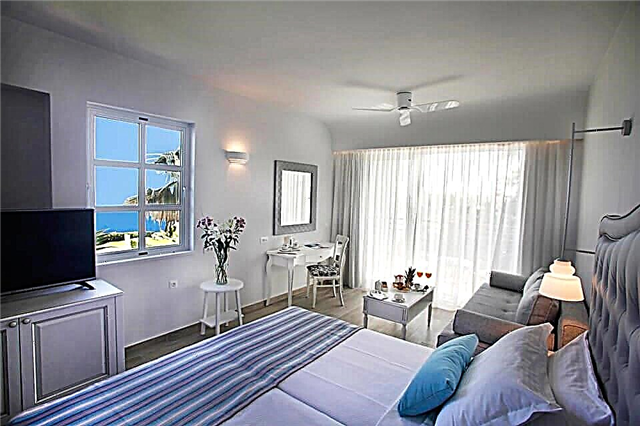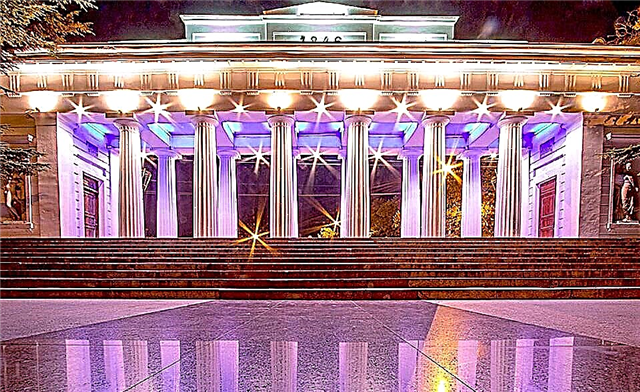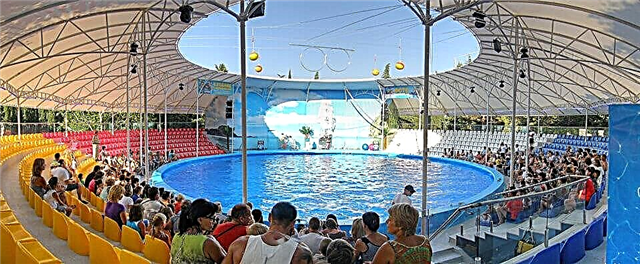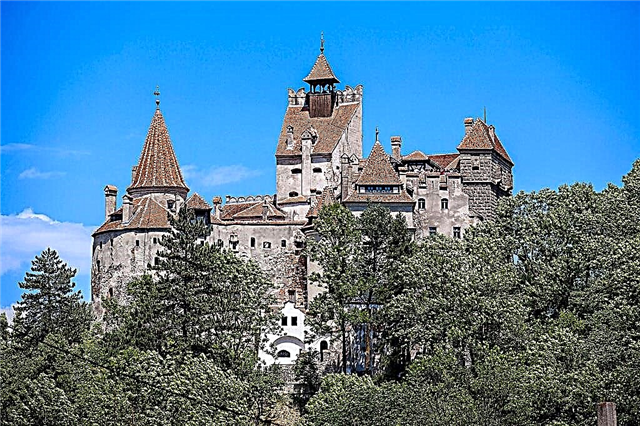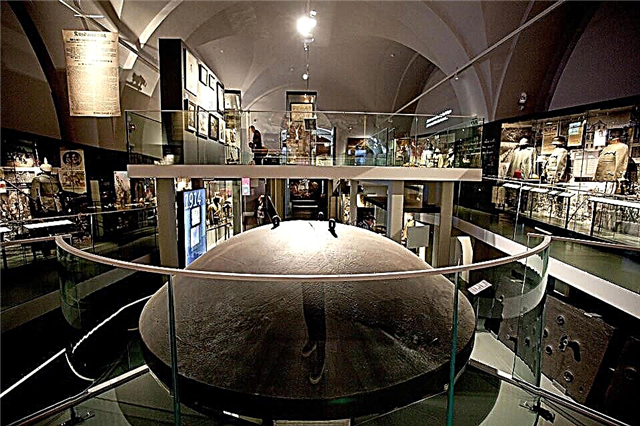The Austrian capital with the affectionate name Vienna is associated primarily with the name of the "king of waltzes" - Strauss, with the enchanting sounds of his music, with Viennese salons, with musical evenings and festivals. But it is also a city of ancient architectural monuments and remarkably interesting museums, a visit to which leaves deep impressions. So, here's a list of the best museums in Vienna.
Albertina Art Museum

The largest museum of art owes its appearance to the enlightened lover of painting and graphics, Duke Albert (1738-1822), who has collected a huge collection of works of art by great masters of the brush from different eras. Today the museum contains in its funds over 900 thousand copies of graphic works, 50 thousand watercolor sketches and drawings by da Vinci, Rembrandt, Rubens, Santi, Durer, Picasso, Dali and many other famous artists. The building of the Albertina Museum itself can also be called a work of architectural art.
After reconstruction in 2003, a titanium slab (64 m) was installed above the entrance, which successfully complemented the external appearance of the museum and has become its modern symbol. An impressive bronze monument to the founder of the museum - Duke Albert, sitting on a "galloping" horse. Now in Albertina in several showrooms there are permanent and temporary exhibitions, there is a solid library, a large reading room, a gift shop. The permanent exhibitions display the works of Monet, Picasso, Renoir, Bacon and other brilliant creators of the brush.
To get a more complete picture of the artistic masterpieces, the museum provides an audio guide service (in many languages, including Russian).
Open every day, from 10.00 to 18.00, on Wednesdays - until 21.00.
Schonbrunn Palace

The former summer residence of the imperial dynasty of the Habsburgs is a magnificent park and palace ensemble, covering an area 1.2 km long and 1 km wide. The majestic palace with 1,441 rooms, built according to the project of Johann von Erlach in the Austrian Baroque style, impresses with its scale and pomp. The architect took the Versailles Palace in Paris as a model. The adjacent park delights with its landscape landscapes, the "Palm House", Henrietta's Pavilion, marvelous fountains, a labyrinth in the spirit of pseudo-Roman ruins and the oldest zoo in Europe.
The old Botanical Garden (1753) deserves special attention - a real work of floristic art, with rare species of trees and shrubs. Today, of all the halls of the palace, only 40 belong to the museum, 190 are leased to private owners. Traveling through the luxurious rooms, one can assess the degree of wealth of the Austrian emperors, see the history of the Habsburg family, whose representatives were born and died here, and abdicated the throne.
Over the years of the existence of the palace, Charles IV, Franz I, Franz Joseph, Maria Teresa lived in it. Here, in several rooms, the headquarters of Napoleon was located at one time. Schönbrunn is the center of incredible beauty, luxury and dazzling wealth. Since 1992, the complex has been taken under the protection of UNESCO.
Palace complex Belvedere

The architectural and landscape pearl of Vienna is not inferior to Schönbrunn in beauty and splendor - another palace and park ensemble Belvedere, which unites two luxurious palaces and a wonderful park. The Lower Palace was built earlier (1714-1716), and the Upper Palace was built in 1722 by order of Prince Eugene of Savoy. Magnificent palaces became his residence, between which a beautiful park was laid out according to the project of the famous landscape designer Girard. Now the Lower Palace houses the Museum of Baroque and Medieval Art with the Marble, Mirror, Grotesque Halls; with the Golden Cabinet.
Here, the palace stable and the greenhouse have been turned into exhibition halls. The Upper Palace houses the Belvedere gallery, conquering with the masterpieces of famous artists G. Klimt, E. Schiele, O. Kokoschka, G. Böckl and other Austrian painters. The original layout of the lawns and fountains of the park is a real miracle of landscape design. The park between the palaces is a comfortable place for a quiet rest for parents with children, lovers and students preparing for exams. The grace of snow-white sculptures against the background of the bright beauty of the flowering trees and bushes of the park, the sparkling spray of fountains, the magnificent view of the palaces, the contents of museums leave the best memories of the Belvedere.
Open for visits: Upper Belvedere - 10.00-18.00, every day
Lower Belvedere - from 10.00 to 18.00, on Wednesday - 10.00-21.00.
Tourist card: discounts and free transport - 17 €
Hop-on hop-off bus tour - € 22.40
Mozart concert at the Golden Hall of the Vienna Philharmonic - 50 €
Tourist card for 1, 2, 3, or 6 days - 59 €
Ferris wheel ticket - 10 €
Entrance tickets to Belvedere - 13 €
Gallery Belvedere

The baroque palace and park complex Belvedere is a masterpiece of architecture and landscape design in the Austrian capital. The amazingly beautiful mansion was built in the 18th century and served as the summer residence of the great commander of his time, Prince Eugene of Savoy. The architectural landmark consists of the Lower and Upper Belvedere. Today, the luxurious halls of the palace house the National Gallery, which consists of a collection of paintings by outstanding masters of the 19th and 20th centuries. Here you can find works by Van Gogh, Renurar, Schiele, Monet, Kokoschka and many other great artists.
The museum displays not only art canvases, but also sculptures made of plaster, marble and wood. The interiors of the Golden, Marble and Mirror Halls of the Lower Belvedere are of particular interest. The walls and ceilings are decorated with frescoes, bas-reliefs and statues. The main pride and pearls of the gallery are the cult works of Gustav Klimt. His works captivate audiences with deep motives of a radiant love passion for women.
For many of his works, the artist used real gold leaf, thanks to which he achieved a unique effect of painting perception. Visitors to the gallery can see such famous paintings by G. Klimt as "The Kiss", "Adam and Eve", "Judith and the Head of Holofernes", as well as "Portrait of Fritz Riedler". The cost of visiting the Upper and Lower Belvedere is 22 euros. The gallery is open daily from 9:00 to 18:00. On Fridays, the museum is open until 21:00.
Liechtenstein Museum

Another magnificent Baroque palace (1700) is a memory of the previous generations of the noble Austrian family of the Liechtenstein princes, whose representatives collected various objects of art. The beginning was laid by Charles I, who had a weakness for expensive furniture, for exquisite jewelry made of gold, silver and precious stones. His descendants continued collecting for 4 centuries, accumulating a large number of valuable rarities during this time. On public display, they began to be exhibited from 1805 until 1938.
Now in the Liechtenstein Museum there are paintings by Italian, Flemish, Dutch, Austrian masters of different eras and trends. Here are the masterpieces of Rubens, Rembrandt, Raphael, Ricci. On display are unique samples of antique furniture, hunting weapons, ivory, bronze and jewelry. The pride of the museum is the Golden Carriage, which was made for the ceremonial trips of Prince J. Wenzel, the 4th prince from the Liechtenstein family. Rococo jewelry, virtuosity of workmanship make the riding carriage a real work of art and priceless treasure.
Every Friday, the museum conducts mass guided tours with an audio guide; on other days, you need to personally agree with the owners of the palace in order to get into it.
Address: Furstenqasse 1.1090 Vienna. Entrance - 20-25 euros.
Hofburg

In the Hofburg palace and park complex, which has 19 palaces, 18 different buildings, 2600 rooms and halls, everything amazes with its grandeur and beauty. Here you can all day consider architectural masterpieces in the style of Gothic, Baroque, Empire, Renaissance and admire the high artistic level of architecture of the past. The first palace received its inhabitants already in 1279 under Leopold VI, but the Hofburg received the status of the winter residence of the Habsburgs in 1533, when new palaces, office premises, and a magnificent park appeared.
Each new emperor strove to complete something, to build another new palace, and thus a real architectural and park miracle was inherited by Vienna. Today, on its 240 thousand square meters. m houses several museums, administrative and government offices, a congress center of international importance, a chapel, "House of Butterflies" and other institutions. "Swiss Wing" - the oldest part of the complex in the form of a fortress, where the guards once served.
The luxurious apartments of the emperors are now a popular museum, where thousands of tourists come to admire the chic interiors of the halls, amazing tableware, wonderful antique furniture, and unique silverware. The design of 19 rooms, bedrooms, living rooms exactly corresponds to the true historical setting of the Habsburg era. Especially many visitors come to the chambers of the famous Princess Elisabeth (Sisi), beloved by the Austrians. In the halls of the empress, the exhibits are her numerous luxurious dresses, stoles, other personal items, gymnastic apparatus.
A peculiar attraction of the Hofburg is the Demel cafe, where you can buy delicious specialties: Sachertorte, candied violets, chocolate "cat's tongues", etc. To enhance the ambiance of the 19th century, the waitresses are dressed in dresses according to the fashion of the time.
World museum

An ethnological and anthropological museum is located in the southern wing of the majestic Hofburg palace ensemble, which is one of the main architectural landmarks of Vienna. For public viewing, more than 250 thousand valuable artifacts have been collected, embodying the historical, religious and cultural heritage of the numerous peoples of Asia, Africa, America, Australia and Oceania.
It is noteworthy that the exhibits previously belonged to well-known navigators, politicians, emperors and patrons of the arts. The basis of the museum fund is the collection collected by the famous travelers James Cook during his long-distance expeditions. In 14 rooms, jewelry, weapons, armor, coins, dishes, clothes, figurines are exhibited. There are also objects of worship, masks, manuscripts, jewelry, musical instruments and other historical items.
The only surviving headdress of the leader of the Aztec tribe deserves special attention. This decoration consists of quetzal bird feathers, leather and over a thousand precious stones. Open daily, except Wednesday, from 10:00 am to 6:00 pm and until 9:00 pm (Friday). The entrance ticket price is 12 euros.
Tower of the Mad

The round tower with thick walls houses a museum whose exhibits do not delight most visitors. This is a pathological museum, where various physiological abnormalities of the human body are demonstrated. Here you can see freaks in alcohol, heads of various people (rumored to be dead criminals), lungs of smokers; amputated arms and legs; human organs affected by venereal diseases (about 4000 exhibits in total). Despite their unpleasant appearance, these "masterpieces" are useful for edification to look at people with bad habits.
The museum inherited this name from the previous designation of the 5-storey tower, which previously housed patients with mental disabilities of varying degrees. The fact that there were violent among them is evidenced by the massive doors, iron chains present in each of the 139 chambers. Among the gloomy exhibits is the head of the assassin of Empress Sisi.
Address: Spitalqasse 2, campus of the university.
Street art gallery

More and more often, on the walls of the austere buildings of Vienna, one can see bright, daring artistic painting, striking in its originality and uniqueness. The art of street art got its development from graffiti, but acquired a large scale: the "canvases" of street artists occupy huge walls, facades, sections of roads and sidewalks. Street art works reflect various plots, carry deep meaning and ideas, so this art has become very popular.
The Vienna Street Art Gallery (2006) is a logical continuation of the development of this new type of artistic painting, where innovative artists have the opportunity to show everyone their brilliant work. Public recognition, high ratings from visitors contributed to the expansion of the street art gallery space. She recently "moved" to a new location on the 1st floor of an old building (170 sq. M). It hosts regular exhibitions of artists from all over the world, organizes seminars for the exchange of experience. Visitors will find interesting encounters with fantastic masterpieces of street art that make city life more fun and joyful.
Address: Stiqenqasse, 2/3.
Opening hours: Tue. - stain. - 12.00-18.00, Sat - 12.00-16.00, closed - Sun, Monday.
Hundertwasser House

A unique residential building with amazing facades was built by the famous architect Friedrich Nundertwasser, who can be considered an Austrian Gaudi - their architectural creations are so similar in originality and expressiveness of execution. A striking example of the fantasy thinking of a genius from architecture is the Nundertwasser House in Vienna. It cannot be overlooked: the kaleidoscopically colored facades, the absence of the usual right angles and lines in the architecture of the building make this house an unrealistically beautiful fairytale object.
Such an avant-garde style was the fruit of a long creative quest of an extraordinary creator who studied impressionism, transautomatism and founded his own academy of creativity - the Pintorarium. Considering that city dwellers are bored of living in standard multi-storey boxes, he created a "cheerful" colorful house with different levels of roofing and windows. The facades of each apartment are painted in different colors; round balconies with delicate railings are entwined with ivy and curly flowers. In some places, trees grow directly from windows or on the roof - a synthesis of urbanism and wildlife, which, according to the architect, is so lacking in the city.
In front of the entrance there is an unusual-looking fountain of intricate design, laid out around the wave-like mosaic paving stones. 50 apartments are inhabited by tenants, of which not all can withstand the pilgrimage of tourists who come in droves to the famous architectural wonder. You can only consider it from the outside, you cannot go inside.
Sigmund Freud Museum
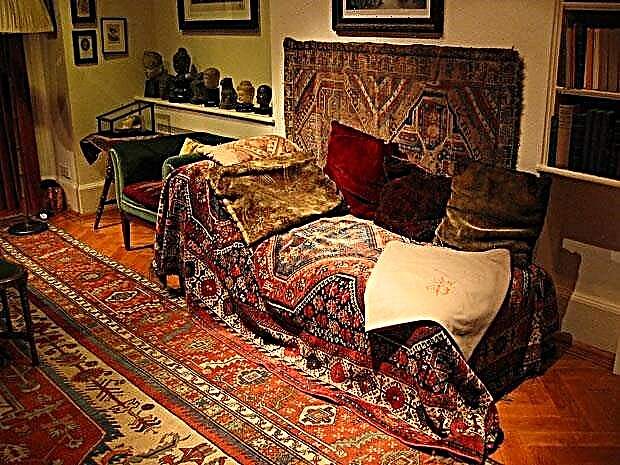
The museum for the famous psychiatrist was opened in the house where he lived with his family for 47 years. The expositions illustrate the life, everyday life and medical practice of the great medical scientist. Here are Freud's personal belongings, his study, a library with scientific literature on psychology, and objects of antique art from his collection. The atmosphere of the reception room, office, waiting room, transferring those present in the era of Freud, has been reliably observed.
Address: st. Bergasse 19. Open for visits: 09.00-18.00 every day.
Museum of art history

The magnificent building, decorated with carved sandstone tiles, with a 60-meter dome, houses a grandiose art museum, with the richest collections of paintings, antiquities, valuable archaeological relics and numismatic rarities. The art gallery of the museum presents a huge number of artistic masterpieces by Bruegel, Durer, Titian, Rubens, Veronese and many other classics of painting from different times, collected by generations of the Habsburgs.
During the Second World War, the building of the museum underwent significant destruction, and it was reopened only in 1959. The most valuable exhibits were hidden before the war, so the museum's collections have been completely preserved. A visit to the museum is a journey through the wonderful world of art, which cannot leave anyone indifferent.
Address: pl. Maria Teresa, U 2.
Accepts visitors: in the summer, every day, 10.00-18.00, Thursday. - until 21.00. spring-winter; Tuesday - Sunday - 10.00-18.00, Thursday - 10.00-21.00.
Leopold Museum

A snow-white building in the shape of a rectangular parallelepiped rises on the territory of the Vienna Museum Quarter. This is a unique building, where the masterpieces of the leading Austrian expressionist painters of the late 19th and early 20th centuries are exhibited for all to see. Oak parquet and an abundance of metal decorative elements give the interiors of the museum premises a special originality.
The exposition is based on the private collection of the ophthalmologist Rudolf Leopold, who is passionate about the avant-garde painting art.
Connoisseurs of the era of modernism will get real pleasure from the perception of the works of Egon Schiele, Gustav Klimt, Oskar Kokoschka and other equally famous artists. Benches are installed in the exhibition halls so that visitors have the opportunity to leisurely look at extravagant, shocking and sometimes overly explicit canvases. Works every day except Tuesday. The doors of the institution are open from 10:00 to 18:00 (Thursday until 21:00). Entry price - 13 euros.
Natural History Museum

It is rightfully considered one of the best scientific and educational institutions in Europe. There are more than 20 million exhibits of historical and archaeological value. Consists of 39 exhibition halls, which contain an impressive collection of unique specimens demonstrating the evolution of flora and fauna, as well as the development of geological processes. The exposition is divided into several thematic scientific departments: mineralogy, paleontology and zoology.
The history of the formation of the first collections dates back to 1750, when the husband of Empress Maria Theresa began to take an interest in rare minerals, precious stones, snail shells and various fossils. As a result, he collected about 30,000 amazing natural objects. Over the years, representatives of the Habsburg dynasty supplemented the collection with new copies. The opening of the Natural History Museum took place at the end of the 19th century. A luxurious Renaissance palace was erected specifically to accommodate the exhibits on Maria Theresa Square.
It impresses visitors with its spacious premises, the total area of which is 8700 square meters. On the ground floor, insects, birds, fish, reptiles, various mammals, skeletons of dinosaurs and primitive people, as well as stuffed animals are exhibited. The second floor is filled with rare minerals, precious stones, meteorite fragments and all kinds of minerals. The luxurious interiors of the palace are of no less interest: wall and ceiling frescoes, bas-reliefs and sculptures.
Tourists seeking knowledge of the world can visit the museum from 9:00 to 18:30 (Wednesday until 21:00). Tuesday is a day off. The ticket price for an adult is 12 euros, for children and adolescents under 19 years old admission to the museum is free.
Military history museum

The hotel is located in the south of Vienna in an old complex of former barracks and weapons workshops. The ensemble of buildings, built of red brick and located in a square on an impressive territory, impresses with its originality. On the facades, you can see the distinctive features of the styles of Byzantine, Moorish and medieval architecture. These are Gothic rose windows, openwork arches, an oriental dome and battlements.
The fund of the museum is divided into five thematic halls, in which exhibits related to different historical eras. The collection of valuable artifacts covers the periods from the 16th to the 20th century. These are small arms and edged weapons, military equipment, uniforms of commanders, helmets, armor, everyday things of soldiers, samples of equipment, artillery pieces, models of ships and submarines, banners, insignia and much more.
History buffs will be interested in exhibits dedicated to the assassination attempt on Archduke Franz Ferdinand in Sarajevo. Museum objects reflect the details of the events that triggered the outbreak of the First World War. Attention is drawn to the car in which the heir to the Austrian throne was shot. Next to the car are the main attributes of that fateful day: the bloody uniform of F. Ferdinand and the genuine weapon of Serbian criminals.
Open daily from 9:00 am to 5:00 pm. The ticket price is 6 euros. You can visit the complex for free every first Sunday of the month.
Technical museum

The exhibition consists of 80,000 exhibits that clearly demonstrate the history of scientific and technological progress. The basis of the collection is equipment that was widely used in the energy sector, economy, mining, heavy industry, mechanical engineering, communications and culture. Many examples are presented in full size, which arouses genuine interest among visitors of all ages. You can see cars, aircraft, computer devices, industrial machine tools, steam engines, locomotives, electric cars, bicycles, and more.
It will be interesting to get acquainted with the rare collection of household items of the last century. These are refrigerators, gas stoves, irons, vacuum cleaners, washing machines, TVs and other respectable home appliances. Until recently, they were an integral part of the everyday life of the household, and now they occupy places of honor in the exhibition pavilion.
On weekdays, open from 9:00 am to 6:00 pm. On Saturday and Sunday, the exhibition is open from 10:00 to 18:00. Adults will pay 13 euros for the entrance ticket. Seniors and students (19-27 years old) can enter the museum for 11 euros.
House of Music

Invites tourists to immerse themselves in the magical world of musical compositions and tonalities of various sounds. The exhibits were housed in the house where the founder of the Vienna Philharmonic Orchestra, the composer Otto Nicolai, lived. Some of the museum's expositions are devoted to his creative activities. Here you can see awards, conductor's sticks, records, concert costumes, musical notation and many other personal belongings of the composer.
It is full of unusual exhibits, which are a multimedia platform with visual effects. All kinds of vibrations of the surrounding world are demonstrated in one of the halls. Here you can hear the rustle of the foliage of the trees, the noise of the metropolis, the roar of the launch of the spaceship, the sounds of the fetus in the womb, the voices of animals, laughter, sneezing, coughing and much more. Museum visitors have the opportunity to create their own musical masterpiece using interactive screens, experiment with different shades of their voices, listen to music with exemplary acoustics, and even control the baton of a symphony orchestra.
It is no less informative to get acquainted with the presented expositions dedicated to the greatest composers: Mozart, Beethoven, Strauss, Haydn, Schoenberg and other musical luminaries. Open every day from 10:00 to 22:00. Entrance fees: for adults - 13 euros, for students - 9 euros, for children under 12 years old - 6 euros.
Museum of Contemporary Art MUMOK

In the Museum Quarter of Vienna, a stylish rectangular gray building with a curved roof and narrow horizontal slots instead of windows rises among the old buildings of the former stables. This building, called MUMOK, has become a repository of modern shocking art. The fund consists of 9,000 exhibits. In the snow-white spacious halls of the complex, original and sometimes quite provocative specimens are placed, most of which contradict common sense.These are paintings, sculptures, audio and video installations, performances, abstract graphic images and photographs.
Many artistic creations leave an ambiguous impression or make one think about the socio-political problems of the modern world. The exhibition is open daily, from 10:00 to 19:00 (Tuesday-Friday), from 14:00 to 19:00 (Monday), from 10:00 to 21:00 (Thursday). Ticket price: 12 euros.
Museum of applied arts

It is one of the most informative institutions in Europe in terms of expositions. Exhibits from different eras, from the Middle Ages to modern days, are presented to the public. These are priceless artistic design masterpieces that were intended for aesthetic pleasure and practical use in everyday life. The exhibition received its first visitors in 1872. On the basis of the museum, a school of applied arts was founded, where famous artists G. Klimt and O. Kokoschka studied.
The total exhibition area is about 2,700 square meters. The spacious halls display numerous items of glass, porcelain, silver and textiles, as well as interior items and magnificent rare furniture. A rich collection of Persian carpets and tapestries, forged sets and precious tableware, oriental figurines and exquisitely painted vases, Venetian lace and Viennese chairs evoke enthusiastic feelings from the audience.
It works every day except Monday. The exhibition is open from 10:00 to 22:00 (Tuesday) and from 10:00 to 18:00 (Wednesday to Sunday). The cost of visiting the museum is 12 euros. Every Tuesday from 18:00 to 22:00 a ticket for tourists will cost 5 euros.
Museum of clocks and clockwork mechanisms

The old three-story Viennese building houses an exhibition of clocks and watch movements. The collection numbers about three thousand different pieces, demonstrating the history of the development of the manufacturing technique and decoration of watchmaking devices since the 15th century. The exposition presents a collection of pocket, wrist, fireplace, table, solar, outdoor, outdoor and pendulum clock mechanisms. The skillful creative work and design solutions of the watchmakers are amazing. Dials are decorated with paintings, vases, figurines, caskets, porcelain and jewelry, as well as other interior items.
The unique astronomical clock "Cajetano", made in the 18th century, deserves attention. They show the length of the day, the movements of the planets in orbit, and even solar and lunar eclipses.
The kingdom of clockwork receives its guests from Tuesday to Sunday. You can visit the museum from 10:00 to 18:00. The ticket price is 7 euros for adults, 5 euros for seniors and students up to 27 years old.
Museum of Forensic Science

In the old building of the former soap factory of the 17th century, a small museum is opened, dedicated to high-profile crimes, the organization of police order and the structure of the judicial system of the times of the Austro-Hungarian Empire. The exhibition halls are filled with a gloomy atmosphere of gruesome criminal cases. The exhibits include authentic protocols and dossiers with descriptions of atrocities, as well as murder weapons, photographs of victims, texts of sentences, material evidence, uniforms of police officers of different years, skulls of criminals and even embalmed fragments of human bodies. The interior of the room has been recreated in the museum, where visitors will see instruments for torturing prisoners.
You can plunge into the chilling world of crime and forensic science for 6 euros. Open from 10:00 to 17:00. Opening hours: from Wednesday to Sunday.
Secession

Not far from the Ringstrasse boulevard, an original cube-shaped building has been erected, which stands out against the backdrop of the majestic architectural ensemble of Vienna. The facade of the building is crowned with a gilded dome with openwork ornaments in the form of intertwined laurel branches. This is the Secession Gallery, which houses works of art that reflect contemporary forms of artistic expression. At the end of the 19th century, the famous Austrian master Gustav Klimt led the community of modernist artists.
The main goal of the union of talented painters was to isolate from traditional conservative trends in art. The first exhibition of the Secession took place in 1898. The new direction in artistic culture made a stunning impression on the audience, who got acquainted with the works of Van Gogh, Edouard Manet, Auguste Renoir and Edgar Degas. The main exhibit of the museum is the famous work of G. Klimt - "Beethoven Frieze". The cycle of wall paintings is dedicated to Beethoven's cult Ninth Symphony.
Open every day except Mondays from 10:00 to 18:00. The cost of the entrance ticket is 9.50 euros. In the Secession, you can see not only the works of contemporary artists, but also video installations.
Children's Museum ZOOM

This is an entertainment complex with interactive themed exhibition halls for children of different ages. The expositions are divided into zones, each of which in a playful way is aimed at the development of vision, hearing, coordination, attention, motor skills and creativity of kids.
Children, accompanied by adults, will be taught to create art installations, cartoons, sculptures, musical works, dance steps, conduct scientific research and learn about the world around them. The guys have a wonderful opportunity to learn the basics of the profession of a doctor, salesman, builder, or test themselves as a parent.
Receives its little guests every day, except Monday. On weekdays, the complex is open from 9:00 to 15:30, on Saturday and Sunday from 10:00 to 16:00. The ticket price starts from 5 euros. The cost of the visit depends on the choice of the theme studio.
House of Mozart

In the historic center of Vienna, not far from St. Stephen's Cathedral, there is an old residential building where Wolfgang Amadeus Mozart's apartments were located on the second floor. This is the only surviving apartment where the great Austrian composer lived from 1784 to 1787. It was in this house that Mozart wrote one of his most famous works, the opera The Marriage of Figaro.
Mozart's current apartment is a popular museum. The exposition aims to recreate the conditions in which the great composer lived and worked. It houses rare furniture sets, interior items, musical instruments, scores, manuscripts, costumes, musical clocks and personal belongings of the composer. The museum also has video installations showing interesting facts from Mozart's biography.
The Museum Apartment is open every day from 10:00 to 19:00. Ticket price - 11 euros (adult), 9 euros (for seniors and students).
Jewish Museum

Its exposition is dedicated to the history of the large Jewish community in the Austrian capital. An impressive part of the collection tells about the creative and social activities of famous Viennese Jews, such as psychologist Z. Freud, writer S. Zweig, politician T. Herzl and composer G. Mahler.
Picturesque canvases, jewelry, assorted dishes, prints, household items, exquisite figurines, ancient manuscripts and other precious artifacts give an idea of the rich cultural identity of the Jewish population. Thanks to animation technology, visitors to the museum can see the former beauty of Vienna's ruined synagogues. Receives guests from Sunday to Friday. Working hours: 10: 00-18: 00. The entrance ticket costs 12 euros.




